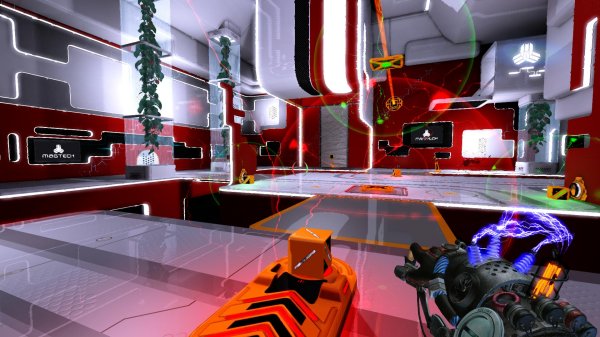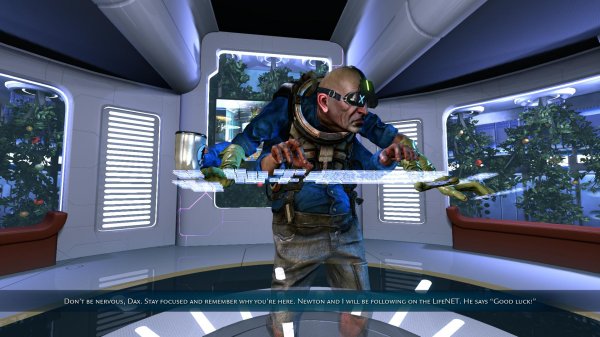Wot I Think - Magrunner: Dark Pulse
How do they work?
There are some games I can see coming from over the horizon. The glow of burgeoning hype - and sometimes the glow of special novelty, or sheer awesome - is so bright that you just can't miss them. Other games, hmm, they pretty much have to be on the same street before I spot them. Whether they will then turn my head as they pass, well, that can come down to any number of things. Usually, though, it's whether they manage to scatter a few intriguing ideas in my path, so that I have to pay attention.
In the case of Magrunner I've been peering at from miles off. Because it just looks that interesting. To use the crude shorthand of thematic conventions, and to get you up to speed: it's Portal with Magnets versus Cthulhu. That's a checklist of ideas that I can't help taking an interest in.
Now that it's been released, here's wot I think.
Quite a few comment-thread onlookers have sniffed their long, sarcastic noses at the combination of Lovecraft and first-person puzzling. It's understandable. Almost any formula of "it's X with Y" where X and Y are relatively familiar cultural elements, is bound to draw scepticism. I feel it too, sceptics. I do. I feel your yearning for the new. But I've nevertheless been pleasantly surprised by how well Magrunner actually works within its seen-it-before fomula. It's just a pleasing experience, and familiarly pleasing, at that. Like a pleasant new sandwich made from everday ingredients.

It goes like this: puzzle after puzzle contrived by use of "magnets" (which are not actually magnets at all, but more on that in a moment) take place in a testing facility that breaks down into madness after you jump through the early tutorial hoops.
Familiar, like I said.
It's not, this time, the breakdown into madness of comedy evil AI, however, but the madness of Old Ones reaching across from nightmare planes to fiddle our minds and chew on our souls. Cultists, things in the water, insane mutterings. That sort of thing. And it's a convenient theme, because Lovecraft never was about shooting things with a gun, it was about the otherworldliness of it all. In a game where the shooting is restricting to elements in a physics puzzle, that's a theme that makes sense.
But taking a step back from this horror precipice: yes, it really is remarkable how much Magrunner borrows from Portal. Hell, there's even a bit where messages are painted on the walls, like they were trying to spell it out for you. The idea of test-chamber puzzles creating a template for the game which breaks down as you go along is the underlying tilt of the whole thing. The constant chatter of voice-overs. The elevators between sections. The very idea of a physics mechanism on which to base those puzzles. Magrunner is, in game design genetics terms, Portal's clever European admirer who might just get accused of plagiarism, but is actually working in a medium that is best understood as intense flattery.

Magrunner's developers, 3AM, know that Portal did everything right, to the point of founding a genre, and they want a piece of that action. And I can't blame them.
Nor can I fault the toolset they've given themselves - and consequently the player - to mess with. The physics puzzle mechanic in this instance is the ability to charge elements of the world - blocks, platforms, and beams - with like charges attracting, and opposite charges repelling. That's the opposite of how actual magnetism works, physics fans! Nevertheless it takes mere moments to realise why the game has been set up like this, rather than attempting to match polar opposites, and that's because it would simply have been insane. As it is, matching and attracting like colours, and repelling and ejecting different colours, makes perfect visual sense, and consequently makes the increasingly complex (although never truly complicated) puzzles are immediately legible. It's a case of game design discovering that its own logic makes more sense that of empirical world.

The puzzles take on numerous aspects, and there's some crafty uses for the ability of the charged objects to remotely affect each other - through walls, for instance. There's also the general motion and lack of inertial damage on the player - you'll be using the magnetics to fling yourself about, without harm. Also familiar.
For the most part, NPCs appear only as holograms - although this changes somewhat as the game progress, for reasons I shall not spoil - but they have a lot to say, and tell a story that I was actually fairly intrigued by. They are by-and-large well acted, which was refreshing in and of itself.
It's worth stressing that Magrunner is a competently produced game. The quality of the detailed game design, though, is variable, with the puzzles oscillating between being ingenious and fascinating, and being snoringly boring. When the game goes off the test chamber format it immediately begins to struggle, although that's not to say that it doesn't achieve some fascinating highs as it plunges into its forty or so challenges. It's occasionally exhilirating to push through these environments, and the shift from shiny sci-fi to weird decay is handled rather smoothly.

Granted, the notion of pseudo-magnetic fields interacting and pushing and pulling objects around in a world isn't as interestinmg as, say, firing portals that link up distant points in space via magical wormhole, but it's still generally enjoyable to play with. Working out how the magnetic fields are going to handle this or that interaction is a unique experience, and on the rare occasion that Magrunner makes genuine use of the clever notion of charged fields (which you can toggle on by hitting F) it does that thing where you glimpse the kind of game mechanic you will want to bore your friends with later on. It's inventive within its own palette, even if it never really surprises.
My lingering feeling, though, was that Magrunner is never quite as a good as the ideas that it is built on. I suspect that's simply because it got stuck somewhere on the difficulty curve of developing such a slippery set of design principles into a full game. Making it err in the side of horror was a great idea, but that too is not always handled that well. There's the occasional moment of brilliance, such as waking up in a padded cell, but it never really sings. The same is true of the puzzles. It's gratifying to play another game where the "gun" is only about physics interactions, but there's a line of intricacy and interesting decipherability that some of the game's set pieces fall below.

I could see a sequel being much bolder and more confident, given these same tools.
Ultimately, this is a big chunk of interesting game and well worth the price of admission. It's by no means a tectonic shift in first-person puzzling, but certainly stronger than some of the other candidates who are exploring the space mapped out by Valve's test chamber opus.
Magrunner, your pulse may be dark, but I think your future could be bright indeed.


